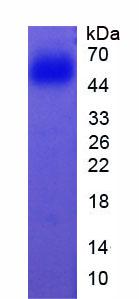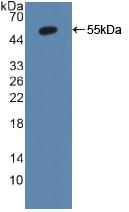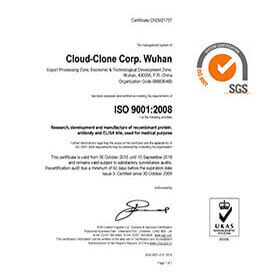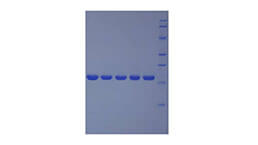Active Cytochrome P450 1A2 (CYP1A2)
CP12; P3-450; P450(PA); Cytochrome P450,Family 1,Subfamily A,Polypeptide 2
- Product No.APD294Hu01
- Organism SpeciesHomo sapiens (Human) Same name, Different species.
- Buffer Formulation20mM Tris, 150mM NaCl, pH8.0, containing 1mM EDTA, 1mM DTT, 0.01% SKL, 5% Trehalose and Proclin300.
- Traits Freeze-dried powder
- Purity> 95%
- Isoelectric Point8.0
- ApplicationsCell culture; Activity Assays.
- DownloadInstruction Manual
- UOM 10µg50µg 200µg 1mg 5mg
- FOB
US$ 380
US$ 950
US$ 1900
US$ 5700
US$ 14250
For more details, please contact local distributors!
ACTIVITY TEST

CYP1A2 (Cytochrome P450 1A2) belongs to the group of proteins which contains heme as a cofactor. CYP1A2 oxidizes a variety of structurally unrelated compounds, including steroids, fatty acids, and xenobiotics. Besides, ASAH1 (Acid ceramidase) has been identified as an interactor of CYP1A2 through affinity capture-MS. Thus a binding ELISA assay was conducted to detect the interaction of recombinant human CYP1A2 and recombinant human ASAH1. Briefly, CYP1A2 were diluted serially in PBS, with 0.01%BSA (pH 7.4). Duplicate samples of 100uL were then transferred to ASAH1-coated microtiter wells and incubated for 2h at 37°C. Wells were washed with PBST and incubated for 1h with anti-CYP1A2 mAb, then aspirated and washed 3 times. After incubation with HRP labelled secondary antibody, wells were aspirated and washed 3 times. With the addition of substrate solution, wells were incubated 15-25 minutes at 37℃. Finally, add 50µL stop solution to the wells and read at 450nm immediately. The binding activity of CYP1A2 and ASAH1 was shown in Figure 1, and this effect was in a dose dependent manner.
USAGE
Reconstitute in 20mM Tris, 150mM NaCl (pH8.0) to a concentration of 0.1-1.0 mg/mL. Do not vortex.
STORAGE
Avoid repeated freeze/thaw cycles. Store at 2-8°C for one month. Aliquot and store at -80°C for 12 months.
STABILITY
The thermal stability is described by the loss rate. The loss rate was determined by accelerated thermal degradation test, that is, incubate the protein at 37°C for 48h, and no obvious degradation and precipitation were observed. The loss rate is less than 5% within the expiration date under appropriate storage condition.
GIVEAWAYS
INCREMENT SERVICES
-
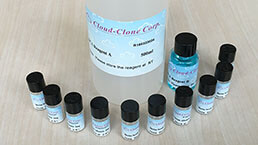 BCA Protein Quantification Kit
BCA Protein Quantification Kit
-
 Molecular Mass Marker for Protein
Molecular Mass Marker for Protein
-
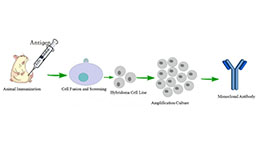 Monoclonal Antibody Customized Service
Monoclonal Antibody Customized Service
-
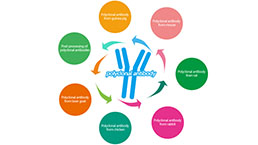 Polyclonal Antibody Customized Service
Polyclonal Antibody Customized Service
-
 Protein Activity Test Experiment Service
Protein Activity Test Experiment Service
-
 Electrophoretic Mobility Shift Assay (EMSA) Experiment Service
Electrophoretic Mobility Shift Assay (EMSA) Experiment Service
-
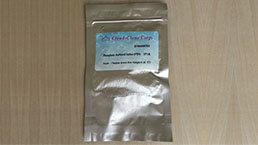 Buffer
Buffer
-
 Lentivirus Packaging Experiment Service
Lentivirus Packaging Experiment Service
-
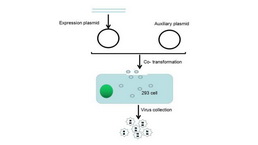 Adenovirus Packaging Experiment Service
Adenovirus Packaging Experiment Service
-
 Real Time PCR Experimental Service
Real Time PCR Experimental Service
-
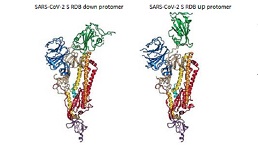 Spike RBD Protein (S-RBD)
Spike RBD Protein (S-RBD)
-
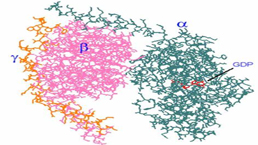 Protein G
Protein G
-
 Protein A
Protein A
| Magazine | Citations |
| Environmental Monitoring and Assessment | Differential expression of HO-1 and CYP1A2 during up-regulation of ERK in stressed fish hepatocytes Pubmed:25471622 |
| The Journal of Nutrition | Apiaceous Vegetable Consumption Decreases PhIP-Induced DNA Adducts and Increases Methylated PhIP Metabolites in the Urine Metabolome in Rats1,2,4 PubMed: 25733458 |
| Molecular Nutrition Food Research | Phenethyl isothiocyanate and indole-3-carbinol from cruciferous vegetables, but not furanocoumarins from apiaceous vegetables, reduced PhIP-induced DNA adducts in Wistar rats Pubmed:27133590 |
| Molecular Nutrition & Food Research | Phenethyl isothiocyanate and indole-3-carbinol from cruciferous vegetables, but not furanocoumarins from apiaceous vegetables, reduced PhIP-induced DNA adducts in Wistar rats. pubmed:27133590 |
| Journal of FisheriesSciences. com | Upregulation of HSP70 Extends Cytoprotection to Fish Brain under Xenobiotic Stress b0407ebde042c4f61b728bc11a586e6c |
| Toxicology | Liver lobe and strain differences in the activity of murine cytochrome p450 enzymes Pubmed:29879457 |
| Stammesspezifische Unterschiede in der analgetischen Wirkung von Buprenorphin bei der Maus |



